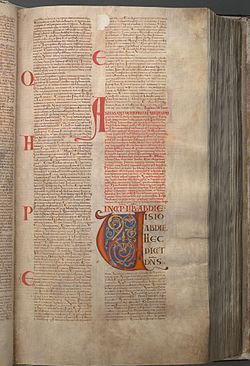| Amos 8 | |
|---|---|
 | |
| Book | Book of Amos |
| Category | Nevi'im |
| Christian Bible part | Old Testament |
| Order in the Christian part | 30 |
Amos 8 is the eighth chapter of the Book of Amos in the Hebrew Bible or the Old Testament of the Christian Bible.[1][2] In the Hebrew Bible it is a part of the Book of the Twelve Minor Prophets.[3][4] This book contains the prophecies attributed to the prophet Amos; in particular, the seventh, eighth, and ninth chapters contain visions and their explanations.[5] This chapter opens with a vision of a basket of summer fruit.[6]
The original text was written in Hebrew. This chapter is divided into 14 verses. Some early manuscripts containing the text of this chapter in Hebrew are of the Masoretic Text tradition, which includes the Codex Cairensis (895), the Petersburg Codex of the Prophets (916), Aleppo Codex (10th century[a]), Codex Leningradensis (1008).[8]
Fragments containing parts of this chapter were found among the Dead Sea Scrolls including 4Q82 (4QXIIg; 25 BCE) with extant verses 1–5, 11–14;[9] [10][11] DSS F.Amos1 (DSS F.181; 1–30 CE) with extant verse 1;[10][12] and Wadi Murabba'at (MurXII; 75–100 CE) with extant verses 3–7, 11–14.[10]
There is also a translation into Koine Greek known as the Septuagint, made in the last few centuries BCE. Extant ancient manuscripts of the Septuagint version include Codex Vaticanus (B; B; 4th century), Codex Alexandrinus (A; A; 5th century) and Codex Marchalianus (Q; Q; 6th century).[13][b]
Biblical commentator Samuel Driver explains:
Partly the thought of Israel's ripeness for judgement, but chiefly the Hebrew word ḳêtz, "end", brings up before the prophet's mental eye in his vision, ... the basket of ḳaitz, "summer fruit". Similarly, in Jeremiah's inaugural vision (Jeremiah 1:11-12), the thought of Jehovah’s watching (shôḳçd) over His word to perform it, produces by association of sounds the image of the almond-tree (shâḳçd), the symbolism of which is afterwards explained, as that of the "summer fruit" is explained here.[16]
The two words, ḳêtz and ḳaitz, are similar in sound, but they are not connected etymologically.[16]
The resolution, I will not pass by them anymore, or Driver's preferred wording I will not again pardon it any more, reflects similar wording in Amos 7:8.[16]